Margaret Atwood
The unexpectedly optimistic outlook of Canada’s uncannily accurate foreteller of times ahead.
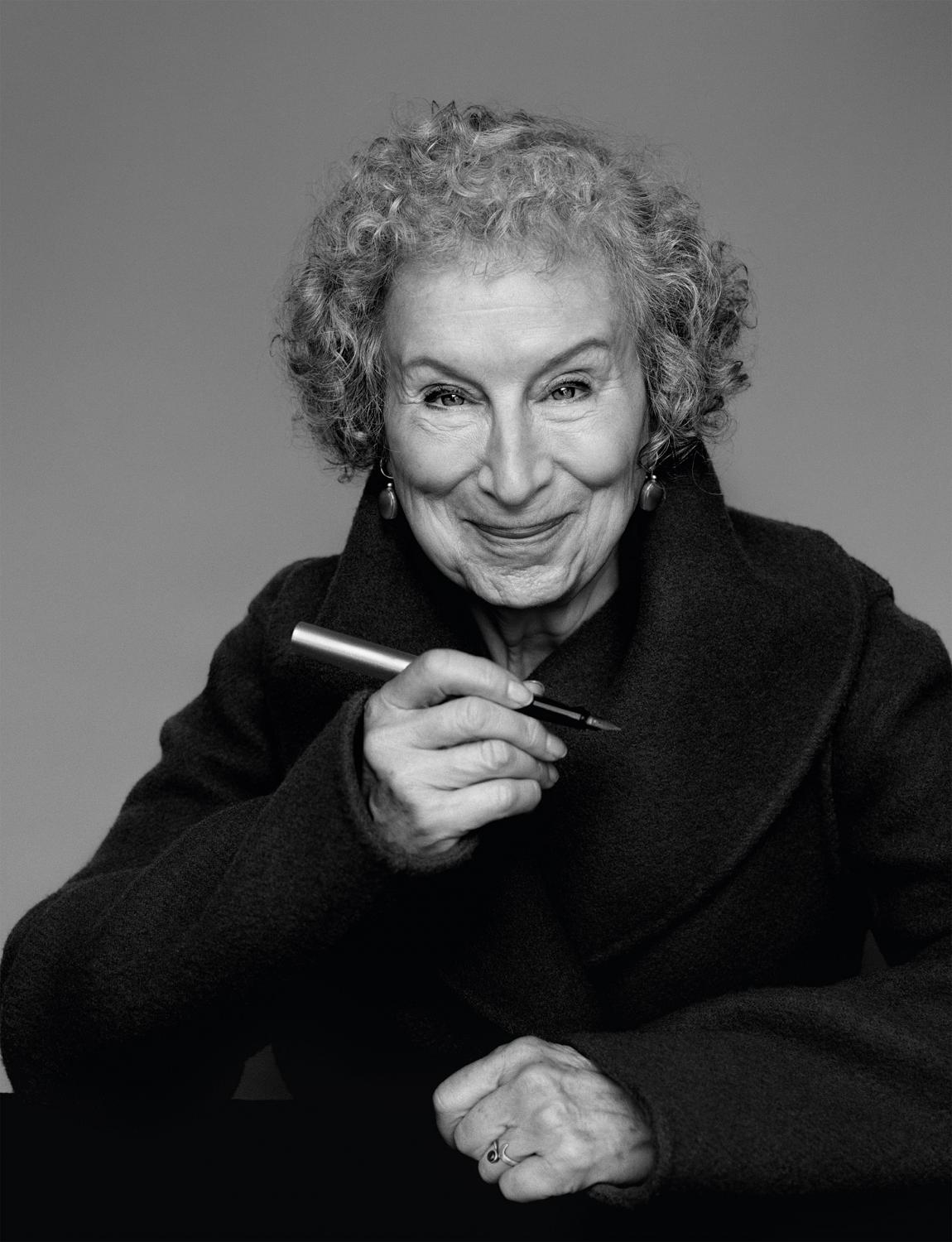
Portraits by Alasdair McLellan
Styling by Alice Goddard
Issue nº 20, Autumn & Winter 2019
Thirty-four years after her most famous novel was published, Margaret Atwood, 79, has written its sequel, The Testaments. It is fresh on the shelves and has already been longlisted for the Booker Prize. In the interim, the events heralded by The Handmaid’s Tale seem distressingly to have been coming true.
So, is Margaret – nature lover, eco-campaigner, armchair scientist – also a soothsayer, a prophet? The author of 64 books – of poetry, non-fiction, and children’s tales as well as novels – has no truck with such a notion, seeing instead possibilities where others see collapse, and enormous hope in a future in which she is fully engaged.
In the middle of the landscape that unfolds in front of Hellens, the haunted Tudor manor house in the Herefordshire village of Much Marcle where Margaret Atwood is staying, there is an elephant waving its trunk in the air. At first glance it appears both lifelike and appropriate: why wouldn’t there be an elephant here, roaming in the long grass by the lake? In this other-worldly place there are also a pond, looming trees and a Victorian vegetable garden. Someone observes that it all feels a little Beatrix Potter, like Mr McGregor’s garden come to life. But this is not the kind of remark you can make lightly in the company of Margaret Atwood, who suggests that Mr McGregor’s garden actually had more rows, and was tidier. Soon enough she is expounding on the seduction narrative of Jemima Puddle-Duck, Potter’s influential Gothicism and the misunderstood heroism of Benjamin Bunny.
This is how conversation goes with Margaret: one thread pulls on another and you just hope to keep track of the unravelling. We sit in Hellens’s grand drawing room under the gaze of sombre family portraits, and as she settles into a vast sofa, red woolly socks reveal themselves under her sandals. For a moment, she seems almost grandmotherly – pink-framed glasses hang on a string around her neck, grey curls surround her uncannily youthful face. But when she looks you in the eye, you understand what you’re dealing with. These are eyes that miss nothing, clear as torchlight. The low, lulling Canadian voice masks an ironic, exacting wit. At one point, talking about the current political culture’s disregard for truth, she argues that facts are starting to matter again. I say I hope she’s right, and she turns quickly, faux-haughty, eyes lit with amusement: “Have I ever been wrong?”
Margaret and her partner, Graeme Gibson, are here for the Ledbury Poetry Festival. This evening she will read aloud some of her own poems, yet to be published, and tomorrow she’ll read a sample of her favourite poems by women. Before the 17 novels, eight books of short stories, 10 works of non-fiction, children’s books and a graphic novel, poetry was how she started. (“If she weren’t a famous novelist, she’d be a very famous poet,” her agent, Karolina Sutton, tells me.) In the early 1970s, Margaret toured the Ottawa Valley in Ontario on Greyhound buses, sleeping on fellow poets’ floors, gathering cash in envelopes from book sales at readings and then giving it to her publisher. I say it sounds idyllic, and she cries out, “No!” It was hard, she says. The climate was hostile. There were hardly any writers, let alone women writers. Her memories of interviews then, if she had any, were of men saying, “I haven’t read your book and I’m not going to.” How would she respond? “Rudely.”
Margaret’s status as a touring writer is a little different now. It is as if the Queen has come to town. Rooms hush when she enters. People automatically fan out to let her pass. One of Ledbury’s booksellers tweets, still in shock: “I sold a book to Margaret Atwood this evening. That. Is. All.” Margaret herself seems unperturbed by the frenzy, or at least professionally oblivious. She is used to such reactions; her literary effect is of such a scale and endurance that she is garlanded wherever she goes. “Her contribution has been to pave the way,” her old friend the publisher and writer Carmen Callil says of Margaret’s influence on multiple generations of writers and readers. “She’s read all over the world by young people.” (The Handmaid’s Tale alone has sold 8 million copies in English.) And not only read but heard, being as engaged with the world as she is with the page. “I think of the good-citizen authors – she’s one of those,” says Lennie Goodings, another friend and the former publisher of Virago, which has published Atwood in the UK since 1979. “She understands what power she can wield and tries to do a good job with that. I like the fact that she understands her power.”
That power has possibly never been as potent as it is right now, as she prepares to publish her next novel, The Testaments, a sequel to The Handmaid’s Tale. On 10 September, publication day, Margaret will be beamed live from the National Theatre in London to 1,000 cinemas worldwide. I wonder how she is preparing for the onslaught. “It’s not my first rodeo,” she replies, drily. But she also expresses rare doubt. “What you’re afraid of is that there will be so much hoopla that when it’s finally published everyone will say, ‘What?’”
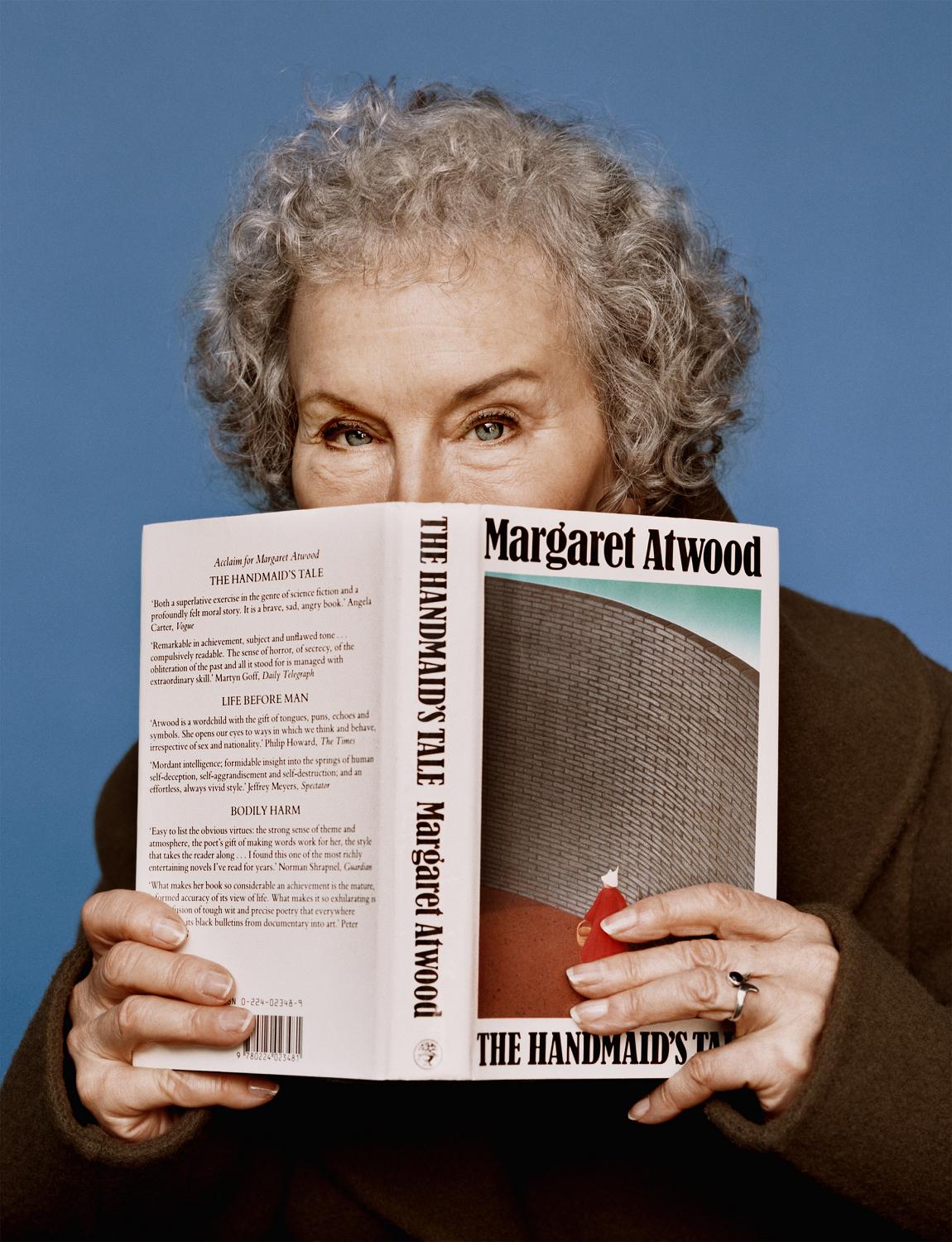
Here and in the opening image, Margaret is wearing a green wool double-breasted coat by LOEWE. The silver-and-garnet earrings are by SLIM BARRETT and the ring is Margaret’s own. They are all worn throughout.
Everyone has been waiting a long time. Margaret wrote The Handmaid’s Tale in 1984, at the age of 45, in West Berlin, on a typewriter. The book has gone on to become a cultural touchstone, a curriculum fixture. It tells the story of Gilead, a fundamentalist Christian theocracy which has overtaken America, from the point of view of Offred, a handmaid, one of the few remaining fertile women who have been spared from exile and quick death brought about by clearing up toxic waste in order to breed on behalf of the ruling class. The Testaments is Margaret’s answer to the questions people have been asking her ever since The Handmaid’s Tale was published. Does Offred escape? How does Gilead fall? What happens next? Margaret decided to answer those questions, she tells me, about three years ago, around the time Donald Trump was chosen as the Republican nominee for president of the US. “It was sort of a tipping point,” she says. “I’d been mulling it over for a while, but things were obviously going to go a lot more pear-shaped than I might have thought they’d go in 1987.”
In recent years, The Handmaid’s Tale has shifted in public perception from a work of speculative fiction, as Margaret describes it, to a horror guidebook to what Trump’s administration might be capable of. It is now read as a kind of prophecy. “I know,” she says, “and I regret that. I regret that circumstances are such that it feels prophetic. Had circumstances been otherwise it would have been dismissed as a paranoid fantasy of the 1980s.” The huge success of the Hulu television adaptation, produced by Bruce Miller, with Elisabeth Moss as Offred, has introduced the story to a vast new audience. But it has become far more than a fiction. Protests borrow the show’s imagery: women dress as handmaids, in red robes and white bonnets, to demonstrate against health-care bills in Washington, DC, abortion laws in Northern Ireland and Trump’s visit to London. It has become a symbol of opposition.
Inevitably, The Testaments will be read as the next chapter of the prophecy. Its action takes place 15 years on from the first book, and so people will pore over it for clues – how will this political nightmare end, how will Trump fall? Margaret, in all this, has been cast as something of an oracle. “People call her Cassandra,” Goodings says. “But she’s not very fond of it.” As Margaret tours universities and literary festivals, her audiences tend to ask nervously for answers, as though she might have some special power to know how events will unfold. “I refuse it!” she says. “You can’t predict the future. Blindsiding events can come out of nowhere and disrupt your whole idea of how things are going to be.”
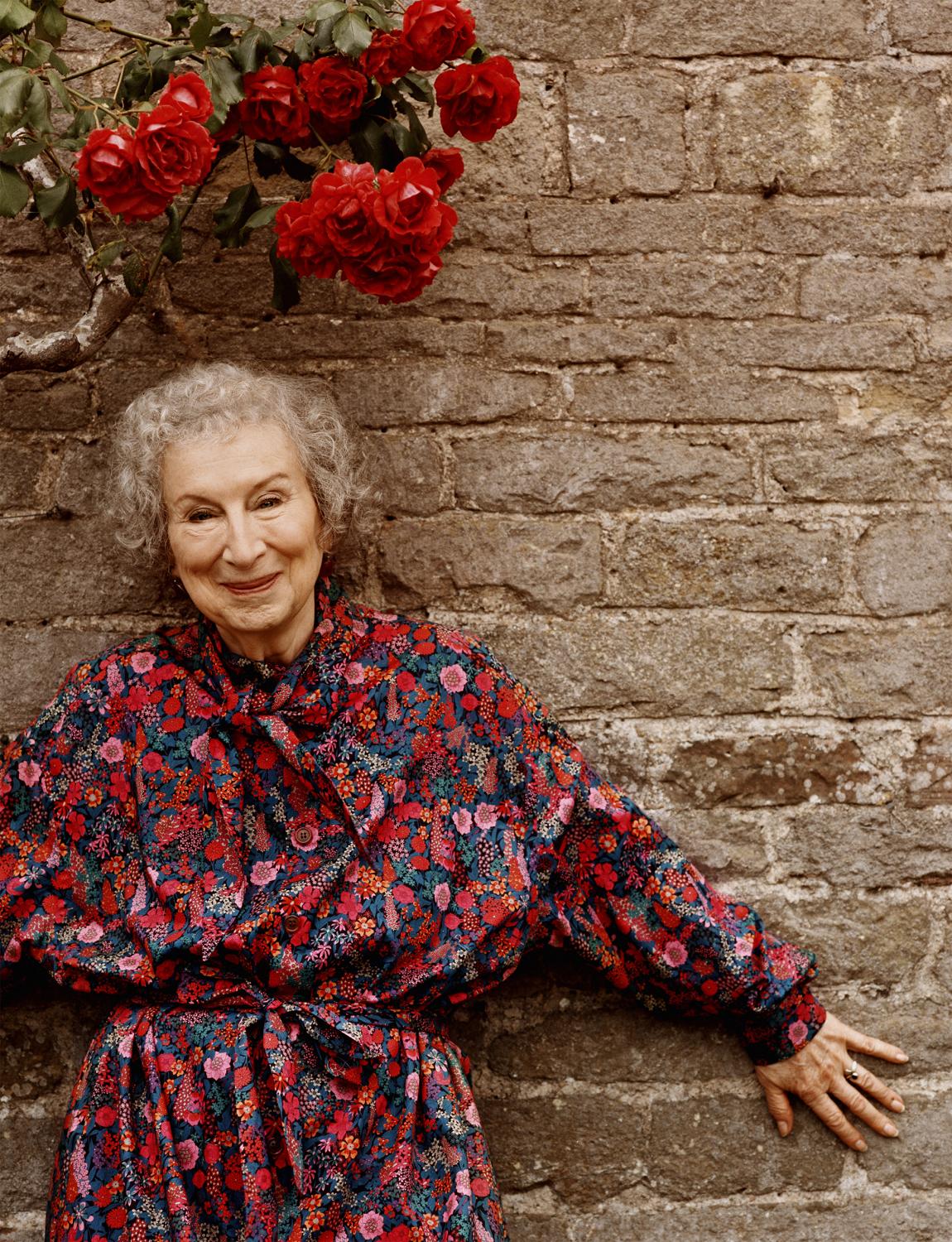
Photographed in the gardens of Hellens in Herefordshire, Margaret is wearing a cotton floral print shirtdress by VIVIENNE WESTWOOD.
When Margaret Atwood decided to be a writer, it wasn’t a career. Or at least no one else thought it was. She told her friends in the school cafeteria it was what she was going to do, as though it were a done deal. “I was quite ignorant,” she recalls. “I didn’t know what would be involved. I just thought, I can do this.” Key to the unquestioning self-belief was not growing up in a community where she felt people were judging her, in contrast to her good friend and fellow Canadian author Alice Munro. “She took pains to conceal in her youth that she was writing, because she thought everyone would laugh at her,” Margaret says, “and she was right. In a community like that [Munro grew up in rural Ontario], they would have. I didn’t have to deal with that at all.”
Margaret’s great advantage was to grow up with almost no community to speak of. The myth goes that she was raised “in the woods”, like some kind of wolf-child, and it’s not so far from the truth. Her father, Carl, was an entomologist, and for large parts of the year the family – Margaret, her parents and her elder brother, Harold, now a neurophysiologist – decamped to the wilderness of northern Quebec, where Carl had an experimental forest insect lab. (Atwood’s younger sister, Ruth, was born in 1951.) Margaret and her brother roamed fairly free, and both have a lifelong devotion to nature, birds in particular, born of weeks on end in the wild. She didn’t attend school full-time until the age of 12, two years ahead of her age group. She was spooked by flushing toilets.
Margaret credits her parents with being forward-looking for their time – they never told her she couldn’t do something because she was a girl. They worried about her writing ambitions, but only because they were anxious about money. They had lived through the Depression, and Margaret was born in 1939, a wartime child who grew up learning not to waste a thing. Her parents knew life could be tough as hell, and they wanted their children to be able to support themselves. There was no question of being pushed to marry a rich man. Luckily, or more likely as a consequence, Margaret was, as she puts it, “a mercenary little kid”. (In high school she and a partner started a puppet-show business that toured toddler parties and became a word-of-mouth hit on the nursery school circuit.)
As a young writer trying to establish herself in what was then a fairly inhospitable non-industry, Margaret was told by her American publisher that she needed an agent. “What’s that?” she replied. Writing was a hand-to-mouth existence, and she had day jobs teaching at universities for years. Crucial to what she agrees is a kind of lifelong bloody-minded perseverance were two aunts, her mother’s sisters, who supported her from the off. “My aunts were sterling. They were stellar,” she says. One, Kae Killam Cogswell, was the first woman to get an MA in history from the University of Toronto; she promptly went home, married the local doctor and had six kids. The second, Joyce Barkhouse, had ambitions to write too, but during Margaret’s childhood was telling stories in Sunday school. She became a well-known children’s author in time (she co-wrote Anna’s Pet with Margaret in 1980), and she encouraged her niece. “I was writing books with sex in them and stuff, which you might think that generation from that place would take a dim view of,” Margaret recalls. “But they backed me up all the way.”
After multiple collections of poetry, Margaret published her first novel in 1969. The Edible Woman was a book “about anorexia before we even knew that word,” Lennie Goodings recalls. Margaret was already well known in Canada, but Goodings remembers reviewers in the UK being slightly mystified by her, and interviewers often misunderstanding – or failing to detect –her subtle humour. Three more novels followed in the 1970s – Surfacing, Lady Oracle and Life Before Man – before the major works of the 1980s and ’90s, including the Booker-nominated novels Cat’s Eye (1988) and Alias Grace (1996).
From her earliest works, Margaret’s reputation as a writer drawn to subjects around gender and sexual politics was confirmed. “We were comrades in a way,” Ursula Owen, a co-founder of Virago, says. “It was the early days of the women’s movement. I know she says she wasn’t writing feminist books, but, you know, she was one of us.” Margaret’s feminism has long been dissected; latterly she has found herself caught up in Twitter-ish storms when expressing a characteristic unwillingness to be boxed in to assumed definitions and opining that the #MeToo movement was the result of a broken legal system. In a column last year in the Canadian Globe and Mail (headline: “Am I a Bad Feminist?”), she stated that her “fundamental position is that women are human beings, with the full range of saintly and demonic behaviours this entails, including criminal ones.”
Looking back, Margaret reflects that the tough part of a writer’s career isn’t the early years, when you’re in your 20s and still deemed youthful and exciting. It’s the next bit: the onset of middle age. “You’re not the young thing and you’re not the éminence grise,” she says, drawing out “griiiise” to the point of delicious parody. These are the long years when you just have to keep going, even though no one’s particularly interested any more. Many authors drift to the sidelines.
Margaret didn’t drift. In her middle period, she wrote The Handmaid’s Tale.
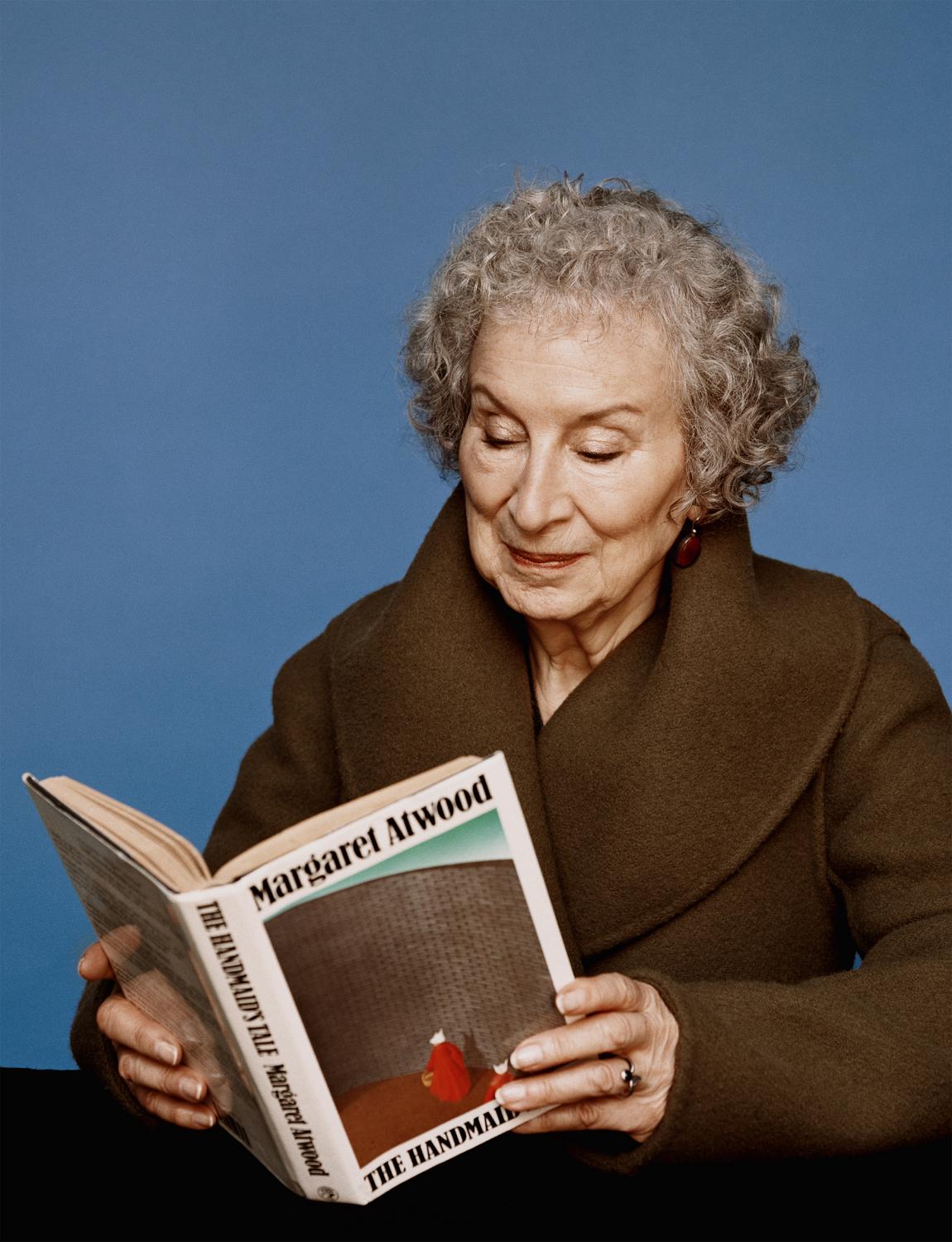
“Had circumstances been otherwise The Handmaid’s Tale would have been dismissed as a paranoid fantasy of the 1980s.”
The “axiom”, Margaret says, of both The Handmaid’s Tale and The Testaments is that every act of imaginative cruelty has happened, in real life, somewhere before. Margaret has the clippings to prove it. For years, she clipped newspapers and magazines and noted down horrors from her large collection of history books. (Now she patiently prints things off the internet or bookmarks them.) The Testaments no longer has Offred’s voice at its centre. Instead, we are given the witness testimony of two teenage girls – one, Agnes, is Gilead born and bred, the child of a commander and his wife; the other is a Canadian who writes school projects on Gilead and campaigns for freedom for its citizens. There is a third strand, too – an account written, you gradually realise, by Aunt Lydia, the headmistress-cum-abusive-godmother figure to the handmaids. No spoilers, I promise, but revelations about Aunt Lydia’s pre-Gilead life follow that seem radical if you’ve only ever considered the character as a figment of your nightmares. At one point, in a flashback to Gilead’s early days, Aunt Lydia describes a prison where the lights are left on all night (just one of many degradations). I realise I’d recently read a description of Trump’s border camps that sounded remarkably similar. “That’s standard,” Margaret says calmly. “They’ve been doing that for years.”
If The Handmaid’s Tale is totalitarianism in its brutal prime, then The Testaments is what happens when the centre no longer holds, when the whole bloody creature starts to consume itself. There are echoes of the death of Stalin here, the brutal fallout of the French Revolution, everyone turning on each other. Like many of Margaret’s books, it is more the product of historical scholarship than a wild guess at the future. She delves, too, into the impact on a generation of young women who have never known anything but the repressive, abusive Gilead regime. “The adult female body was one big booby trap, as far as I could tell,” Agnes writes. “If there was a hole, something was bound to be shoved into it and something else was bound to come out. There were so many things that could be done to it or go wrong with it, this adult female body, that I was left feeling I would be better off without it.”
Then there is the other side: the heroics of those who hide refugees, the intricate underground networks of spies and rebels, escape channels and safe houses. The French Resistance served as inspiration. Margaret tells me the story of her friend François, who escaped execution during the Second World War by being smuggled into Spain, where he was interned by General Franco. He was then traded by the British for a sack of flour. “But it was a verrrry biiig sack,” Margaret says. He went on to work with French intelligence in London under Charles de Gaulle. I ask her how they met. “I knew him in the south of France,” she replies with tantalising vagueness.
The process of writing The Testaments was in some ways typical of all her writing – she did it in hotel rooms, on aeroplanes and trains, wherever she happened to be. Planes, Margaret says, are her friends. “Unless I get decoyed into watching, as recently, Captain Underpants.” But this time she had to contend with an extra challenge. While she was writing, the team behind the television adaptation of The Handmaid’s Tale were deep into creating the third series, which goes beyond the novel’s narrative. It’s hard to think of another example like this – Game of Thrones comes close in that the showrunners completed George RR Martin’s story before he had written the final book. But that wasn’t a simultaneous process. Margaret would have regular conversations with the producer, Bruce Miller, while they were both writing. “I said, ‘You cannot kill this person off, or this person, or this person,’” she says. “He was fine with that.” I wondered who’d seeded the name Nicole, which belongs to a character who appears first in the television show and is also in the new book. On this, Margaret is very clear: “I said she had to be Nicole.”
The show has stuck to Offred’s story, but Margaret has now expanded Gilead’s horizons. Of Miller, she says, “I’ve given him a whole new canvas.” There could be who knows how many more seasons, filling in the gaps. They could even do a prequel, an Aunt Lydia spin-off. But there was also cross-pollination in the other direction. “I was inspired by the performance of Ann Dowd, who gave Aunt Lydia more dimensions than she had in the original book,” Margaret tells me. As for Miller, he says working with Margaret is pure pleasure. He runs scripts by her and asks her advice on how things might turn out for a particular character. “It’s like having a writer in your writers’ room who’s much better read than you are and much smarter than you,” he tells me by phone from Los Angeles. “She’s like 30 steps ahead of me all the time.”
Later in the evening, Margaret arrives at the community hall in Ledbury to read her poetry. The hot, packed crowd whisper to each other as she climbs the stairs to the stage, a sheaf of loose pages poking out of her large black bag. The room adjusts to her presence, a shuffling deference among the rows. She is introduced by Ursula Owen, who gives the expected fulsome introduction. All the books, all the awards. Then Margaret steps up and says she asked Ursula earlier if she should sing a song about Canada to kick off. Ursula said yes. So Margaret begins, in a slightly tremulous but strangely compelling voice, to sing “Canada’s Really Big”, by a Canadian band called Arrogant Worms. “When I look around me, I can’t believe what I see / It seems as if this country has lost its will to live! / The economy is lousy, we barely have an army / But we can still stand proudly ’cause Canada’s really big!”
The room bursts open with laughter – the lyrics are witty, sure, but mostly it’s out of delighted surprise. “I didn’t know she was funny,” someone sitting near me says.
Here’s the thing: Margaret is funny all the time. She’s funny even when she’s talking about torture regimes and how the world might end, which is quite often. She’s also unexpectedly optimistic, more hopeful than you might imagine the creator of literature’s most notorious dystopia to be. The Testaments ends on what feels like a happy note. “Well, it’s qualified optimism,” she corrects me. “These things do come to an end. They do, one way or another.”
Some of the poems she reads in Ledbury are fairly unrelenting in their bleakness. One imagines a near-future world in full-blown climate crisis and how its children will fare: “Will your eyes blank out like the white eyes of sunless fish?” But despite these moments that prompt low groans from the crowd, she always manages to lift the mood. She lets the audience vote on the tone of the last poem she’ll read: “Mean or gloomy?” And when a worried questioner asks if the end is nigh, she tells them to go to the website of Project Drawdown, a compendium of various global schemes to reduce CO2 in the atmosphere. (When I visit the website a few days later, the testimonial on the home page is from Atwood.)
“Have I ever been wrong?”
Environmentalism has been Margaret’s bag for decades, from the time when relentless forest fires and floods represented a future threat rather than a daily reality. She’s a lover of birds and an advocate for their conservation – of course she is, the kid from the woods – but she’s also a campaigner. She’s been in the game long enough to see possibility as opposed to inevitable collapse. “People are making efforts. The question is, will the efforts be enough? Not enough to avoid the weather blips we’ve been having, but possibly enough to avoid us choking to death because the oceans die.” Qualified optimism, as she says.
At home in Toronto, Margaret checks the weather blips obsessively on her computer – partly out of an interest in the planet, mostly out of an interest in the garden that she tends with care. She goes for regular walks. “Where do I walk? Hither and thither.” The walks usually happen with a friend, and their ultimate purpose is usually a latte and a scratch card. “Cheap thrills,” she says. She looks after Graeme, her partner, who, as she puts it, “isn’t 35 any more”, and she has a daughter, Eleanor, 43; two stepsons, Matt and Grae, now in their 50s; and three grandchildren, aged 18, 16 and three, to whom, she says, she’s a reasonable grandmother. I suspect this is typical understatement. One of her poems is about picking blackberries with a child, as her grandmother did with her. There’s a sense of generation to generation, a chain of love. When I ask if she struggled with her children growing up, with having to let go, with the quotidian gut pain that defines parenthood and grandparenthood, she replies, “Oh, of course. I think it’s the going away to college – everybody goes ‘Waaah.’” She feigns tears. “But then they’re back with the laundry.”
For years she’s been giving all her papers (575 boxes and counting) to the University of Toronto’s Thomas Fisher Rare Book Library. “You have to get them out of the house,” she says. Her reading matter must take up masses of space. In a single conversation, you get a sense of its span: a constantly updating roll call of contemporary fiction and poetry, but also swathes of history – Russia, China, Europe – spliced with niche academic papers on hormones. When I ask her what publications she reads regularly, we only get as far as the scientific ones – Scientific American, New Scientist, Science News, Discover, National Geographic, Nature – before her mind is diverted elsewhere. On her energetic Twitter feed (1.94 million followers) she is constantly recommending young authors and books by friends and linking to articles from round the world. Her brain is one of those lucky ones that seems to absorb knowledge by osmosis and then not to shed it, ever. Towards the end of our conversation, in another Beatrix Potter segment, she started to sing a song about Peter Rabbit she’d overheard being rehearsed in her classroom when she was 13. She was word-perfect, the lyrics all there, mentally filed next to Bolshevik history and mass extinction events.
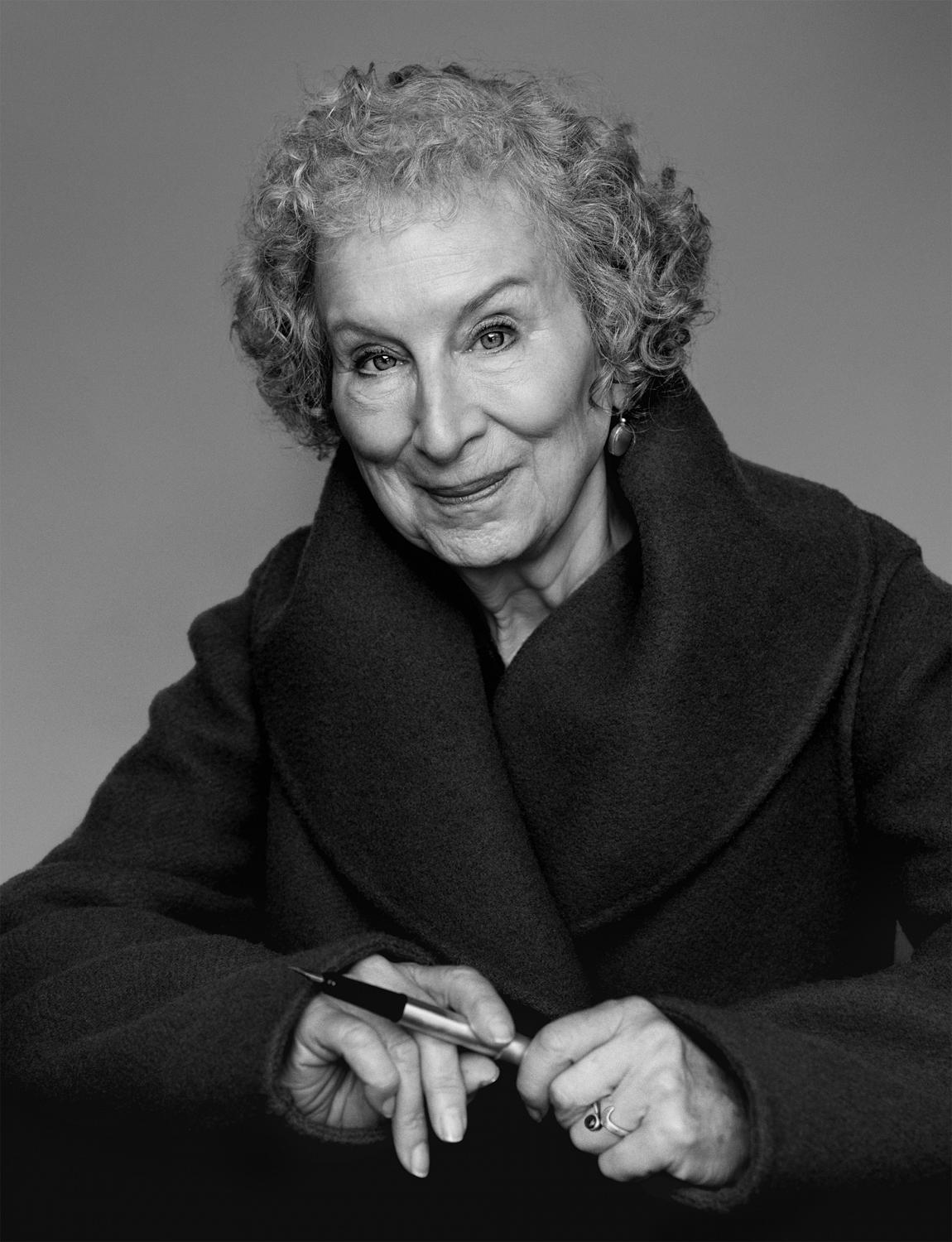
Margaret has patented six inventions. The first, in 2006, was the LongPen, a device that enables one to write on a tablet and the words to appear in ink, reproduced by robotic hand, anywhere in the world. It’s ideal for remote book signings, though Margaret endeavours to inscribe as many of her novels as possible in person.
By the time Margaret turns 80 in November, she will most likely have had the most intensive, high-octane year of her life. She will delight in it, all the encounters and stimulation. The night before we met, she’d been at dinner with a Chinese survivor of Tiananmen Square and a Swedish folk band; and was apparently equally tuned in to both worlds. But this is also a stage of life when friends start to fall by the wayside. Margaret’s old schoolmates used to come to her readings and accost her with renditions of a home economics musical she wrote in high school, but at least two of the leads have now died. Her mind inevitably tilts towards her own death. Her current, extremely Atwoodian preoccupation is how to dispose of her corpse in an environmentally responsible way. She has become taken by the idea of it being “recomposed” – that is, put in a pod in a facility, left to decompose and then turned into compost that can be sprinkled on plants. “You can get a mushroom coffin now,” she says, impressed. “So I might do that.” The odour-proofing must be pretty good at the facility, I suggest. She gives me a look. “Je suppose.” In Margaret’s world, even death is a potential opportunity to engage with the world (she is a seed investor in the Seattle facility Recompose, which, she tells me, used to be called the Urban Death Project).
She has also ensured that her work is safely lodged in the future. Five years ago, she was the first writer to contribute to the Future Library project, an idea conceived by the Scottish artist Katie Paterson in which every year for 100 years a writer will deposit a work in a specially designed room at the Oslo public library in Norway. The room will not be opened until 2114. “She was my first choice,” Paterson tells me. “Her voice goes across generations.”
A thousand trees were planted in the Nordmarka forest at the project’s inception. The whole idea, Margaret says, is one containing enormous hope. Hope for the trees that will grow; hope for a future world that will still contain libraries, books, readers. No wonder people turn to her for answers, for soothsaying; she has an eye on all that is to come, and she sees possibility. If she has a message for you, it is only this: “It’s not over.” From her expression – that cool, still gaze – I swear she does actually know something we don’t, that somehow she can see it. But maybe that’s just blind hope on my part. She repeats, insistent, “It’s not over! Democracy is not over.”
Sophie ElmhirstLondon based journalist Sophie is a regular contributor to the Guardian, The New York Times, the New Yorker and the Financial Times. Honours in the Elmhirst cabinet include a British Journalism Award for feature writer of the year and a Foreign Press Association award for finance and economics story…read more Portraits by
Alasdair McLellanOne of the leading fashion photographers working today, Alasdair McLellan is noted for his warm, intelligent portraiture, which has featured in Fantastic Man, Self Service, multiple Vogues and Love, among many other quality titles. Originally from Doncaster, Alasdair is a fan of 1980s super-producers…read more Styling by
Alice Goddardread more
Hair: Shon Hyungsun Ju at The Wall Group. Make-up: Niamh Quinn at LGA Management, using Omorovicza. Manicure: Rosie Biggs-Wood. Photographic assistance: Matthew Healy, Simon Mackinlay. Styling assistance: Anastasia Xirouchakis. Production: Rosco Production.
This profile was originally published in The Gentlewoman nº 20, Autumn & Winter 2019.